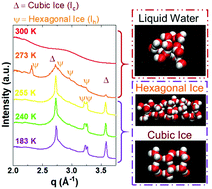Structure of ice confined in silica nanopores†
Abstract
Observed anomalous thermodynamic properties of confined water such as deviations in the melting point and freezing point motivate the determination of the structure of confined water as a function of pore size and temperature. In this study, we investigate the dynamic evolution of the structure of confined ice in SBA-15 porous materials with pore diameters of 4 nm, 6 nm, and 8 nm at temperatures ranging from 183 K to 300 K using in operando Wide-Angle X-Ray Scattering (WAXS) measurements, X-Ray Partial Distribution Function (PDF) measurements, and classical Molecular Dynamics (MD) simulations. Formation of hexagonal ice structures is noted in all the three pore sizes. In silica nanopores with diameters of 4 nm, cubic ice formation is noted in addition to hexagonal ice. Longer lasting hydrogen bonds and longer residence times of the water molecules in the first coordination shell contribute to observed crystalline organization of ice in confinement. Self-diffusion coefficients of confined liquid water, predicted from classical MD simulations, are four orders of magnitude higher compared to ice formed in confinement. These experimental and simulation results provide comprehensive insights underlying the organization of confined water and ice in silica nanopores and the underlying physico-chemical interactions that contribute to the observed structures.



 Please wait while we load your content...
Please wait while we load your content...